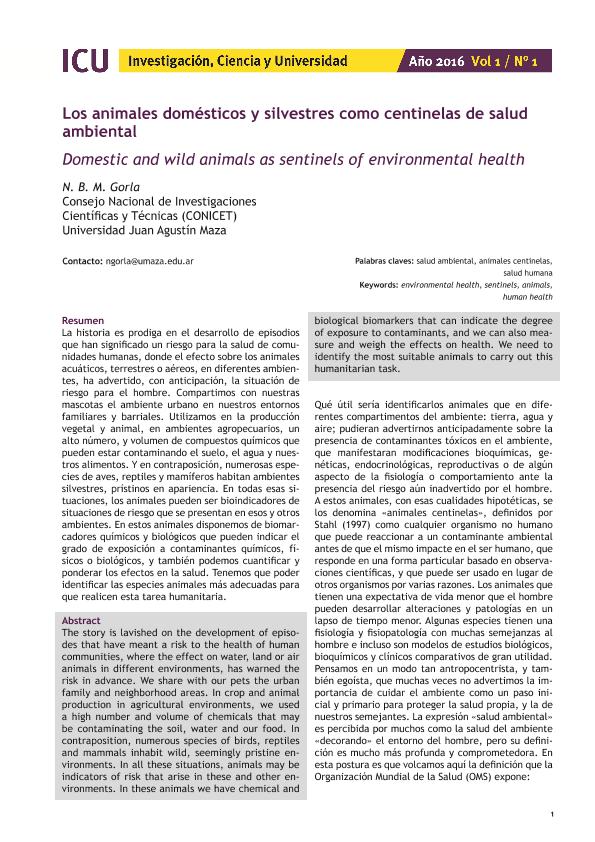Mostrar el registro sencillo del ítem
dc.contributor.author
Gorla, Nora Bibiana Maria

dc.date.available
2020-04-03T21:13:15Z
dc.date.issued
2016-12
dc.identifier.citation
Gorla, Nora Bibiana Maria; Los animales domésticos y silvestres como centinelas de salud ambiental; Universidad Juan Agustín Maza; Investigación, Ciencia y Universidad; 1; 1; 12-2016; 1-7
dc.identifier.issn
2525-1783
dc.identifier.uri
http://hdl.handle.net/11336/101981
dc.description.abstract
La historia es prodiga en el desarrollo de episodios que han significado un riesgo para la salud de comunidades humanas, donde el efecto sobre los animales acuáticos, terrestres o aéreos, en diferentes ambientes, ha advertido, con anticipación, la situación de riesgo para el hombre. Compartimos con nuestras mascotas el ambiente urbano en nuestros entornos familiares y barriales. Utilizamos en la producción vegetal y animal, en ambientes agropecuarios, un alto número, y volumen de compuestos químicos que pueden estar contaminando el suelo, el agua y nuestros alimentos. Y en contraposición, numerosas especies de aves, reptiles y mamíferos habitan ambientes silvestres, prístinos en apariencia. En todas esas situaciones, los animales pueden ser bioindicadores de situaciones de riesgo que se presentan en esos y otros ambientes. En estos animales disponemos de biomarcadores químicos y biológicos que pueden indicar el grado de exposición a contaminantes químicos, físicos o biológicos, y también podemos cuantificar y ponderar los efectos en la salud. Tenemos que poder identificar las especies animales más adecuadas para que realicen esta tarea humanitaria.
dc.description.abstract
The story is lavished on the development of episodes that have meant a risk to the health of human communities, where the effect on water, land or air animals in different environments, has warned the risk in advance. We share with our pets the urban family and neighborhood areas. In crop and animal production in agricultural environments, we used a high number and volume of chemicals that may be contaminating the soil, water and our food. In contraposition, numerous species of birds, reptiles and mammals inhabit wild, seemingly pristine environments. In all these situations, animals may be indicators of risk that arise in these and other environments. In these animals we have chemical and biological biomarkers that can indicate the degree of exposure to contaminants, and we can also measure and weigh the effects on health. We need to identify the most suitable animals to carry out this humanitarian task.
dc.format
application/pdf
dc.language.iso
spa
dc.publisher
Universidad Juan Agustín Maza
dc.rights
info:eu-repo/semantics/openAccess
dc.rights.uri
https://creativecommons.org/licenses/by-nc-sa/2.5/ar/
dc.subject
SALUD AMBIENTAL
dc.subject
ANIMALES CENTINELAS
dc.subject
SALUD HUMANA
dc.subject
GENOTOXICIDAD
dc.subject.classification
Otros Tópicos Biológicos

dc.subject.classification
Ciencias Biológicas

dc.subject.classification
CIENCIAS NATURALES Y EXACTAS

dc.title
Los animales domésticos y silvestres como centinelas de salud ambiental
dc.title
Domestic and wild animals as sentinels of environmental health
dc.type
info:eu-repo/semantics/article
dc.type
info:ar-repo/semantics/artículo
dc.type
info:eu-repo/semantics/publishedVersion
dc.date.updated
2020-03-20T13:18:06Z
dc.journal.volume
1
dc.journal.number
1
dc.journal.pagination
1-7
dc.journal.pais
Argentina

dc.journal.ciudad
Mendoza
dc.description.fil
Fil: Gorla, Nora Bibiana Maria. Universidad "Juan Agustín Maza"; Argentina. Consejo Nacional de Investigaciones Científicas y Técnicas; Argentina
dc.journal.title
Investigación, Ciencia y Universidad
dc.relation.alternativeid
info:eu-repo/semantics/altIdentifier/url/http://repositorio.umaza.edu.ar/handle/00261/830
Archivos asociados
